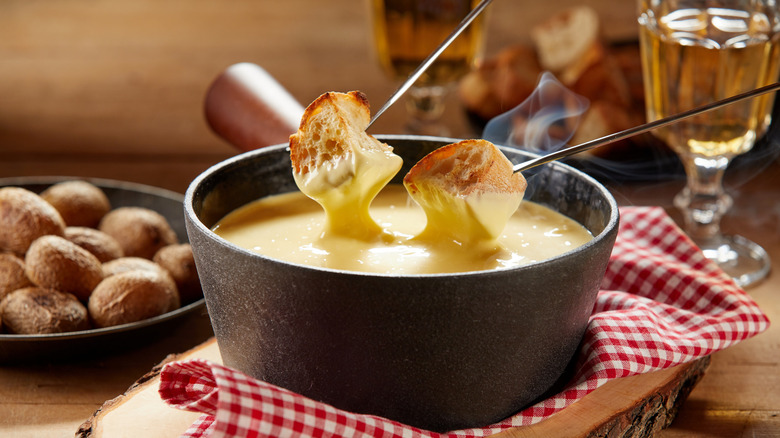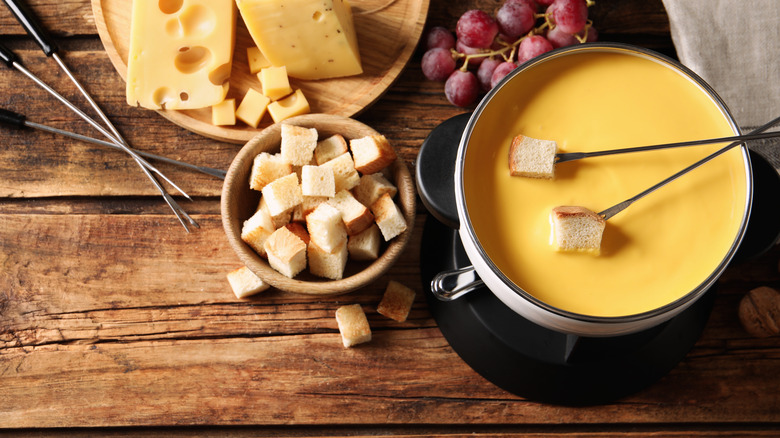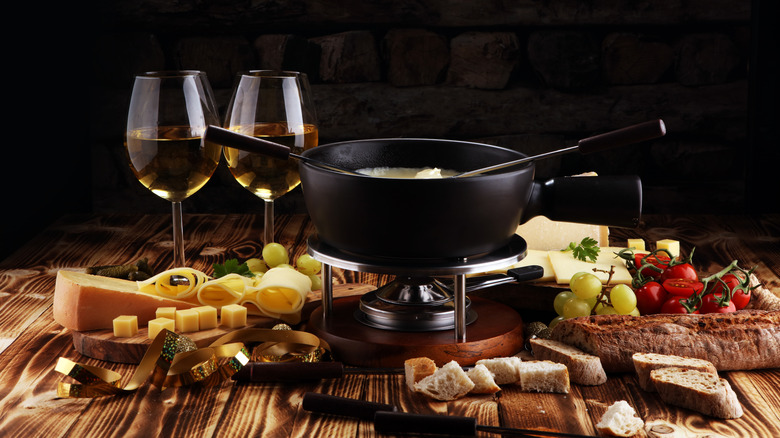The Hidden Delicacy At The Bottom Of Every Fondue Pot
Fondue, a dish with regional origins, evolved in Switzerland in the 18th century as a means for farm families to use leftover bread and cheese during the long, cold Alpine winters. Nowadays, people around the world enjoy bread dipped in warm, melted cheese with added flavors from herbs, spices, or even brandy, without needing a seasonal excuse.
Yet, there's value in exploring traditional Swiss fondue culture, which offers tips and tricks for an even more delicious fondue experience. For example, after enjoying fondue, it's worthwhile to scrape off the crusted cheese that remains stuck to the pot. In Switzerland, these crusted brown pieces are called "la religieuse," named after a type of French pastry whose name translates to "the nun."
However, you don't need to be part of a religious order to appreciate the divine nature of this fondue practice. The browner and crustier these pieces are, the more delicious they become when scraped off and enjoyed.
How to remove crusted cheese from fondue pots
Saving the crusted cheese at the bottom of your fondue pot isn't the only thing you can learn from Swiss culture — it turns out, cheese fondue has its own etiquette rules. Did you know there are only three drinks traditionally served with fondue in Switzerland? White wine, which can also be added to the fondue for flavor, kirsch (a European cherry brandy), and herbal tisane tea are the preferred pairings. Additionally, using authentic Swiss cheese in your fondue pot is recommended.
However, preserving the cheesy remnants requires specific know-how. After all, removing these burnt bits for cleaning purposes is often quite difficult; saving them so that they remain edible and delicious is another challenge entirely. Understanding how the crust forms in the first place is crucial to ensure you have plenty to enjoy later.
To prepare fondue in the Swiss manner, complete with a crusty bottom, stir clockwise using a wooden spoon or spatula to scrape off la religieuse. Why wooden? Fondue pots are made from various materials, and metal utensils can scratch or damage most of them, including the traditional enameled cast iron.
Altternate uses for la religieuse
One traditional way to reuse la religieuse in Switzerland involves adding eggs to the pot after the crusty bits have been scraped off, ready for a new culinary pairing. For instance, making fried or scrambled eggs with la religieuse is popular among the Swiss, even if some non-crusted cheese remains in the pot, resulting in a creamier version. Adding not just eggs, but also potatoes and bread, is another option to make the most of the crusty cheese bits.
Of course, enjoying la religieuse on its own is perfectly fine, as is saving it for the next day to be eaten as a snack with bread, or with breakfast staples like bacon and eggs. Eating it the same night has its advantages, in that you can finish off your fondue pot in true Swiss style. What's the ideal follow-up to fondue? Contrary to popular belief, it's not chocolate. That's an American innovation.
Instead, complement your cheesy fondue with a bowl of fresh fruit salad. Consider it a refreshing Swiss-style palate cleanser. And feel free to enjoy another glass of kirsch as well.



